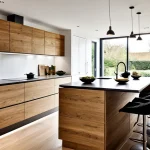Minimalist Kitchen Transformation Essentials
Minimalist kitchen design revolves around simplicity, functionality, and clean lines, which are fundamental in any kitchen transformation. The core principle is to create a space free of unnecessary items, focusing only on essentials. This approach ensures your kitchen remains both aesthetically pleasing and highly practical.
Key elements defining a minimalist kitchen include neutral color palettes, streamlined cabinetry without ornate handles, and integrated appliances that maintain visual harmony. These features contribute to a cohesive look that emphasizes openness and order. Surfaces are kept clear, enhancing the feeling of space and making daily cooking more efficient.
In the same genre : Revamp your uk kitchen: tips for infusing sleek style with slim designs
Embracing minimalism in your kitchen transformation also means prioritizing storage solutions that hide clutter rather than display it. This strategy optimizes functionality while keeping the environment calm and inviting. For example, deep drawers, pull-out pantries, and concealed trash bins are common elements that support a clutter-free kitchen.
By maintaining these essentials, a minimalist kitchen becomes not just a place to cook but a sanctuary that promotes ease and clarity, perfectly embodying modern kitchen design principles.
Have you seen this : Unlocking maximum functionality: creative tips to optimize your small kitchen space
Inspiring Minimalist Kitchen Design Ideas
Explore clean lines and functional elegance
Minimalist kitchen ideas focus on clutter-free spaces with sleek designs that emphasize function and form. Popular minimalist kitchen layouts often feature open-plan designs, integrated storage, and streamlined cabinetry that reduce visual noise. A common approach is the L-shaped or galley kitchen layout, which maximizes workspace while maintaining simplicity.
Trending materials and textures play a vital role in minimalist kitchen inspiration. Matte finishes, natural wood, and monochrome palettes—such as white, black, or muted greys—create a calm ambiance. Fixtures often include handleless cabinets, hidden appliances, and minimalist lighting like recessed LED strips. These elements not only look elegant but are practical for easier cleaning and upkeep.
Before-and-after kitchen makeovers often highlight how removing excess woodwork or elaborate decorations can transform a busy kitchen into a serene environment. For example, replacing bulky countertops with thin slabs of quartz or concrete instantly modernizes the space while enhancing durability. Incorporating these minimalist kitchen ideas leads to an inviting yet highly functional area, ideal for those who appreciate refined simplicity without compromising utility.
Step-by-Step Guide to Achieving a Minimalist Kitchen
Creating a minimalist kitchen starts with intentional decluttering. Begin by evaluating your kitchen essentials. Ask yourself which items you truly use daily and which ones simply take up space. Prioritize functional tools and appliances that contribute to your cooking routine. Removing duplicates and unnecessary gadgets is crucial to maintaining simplicity and clarity in your space.
Next, focus on selecting minimalist color palettes and finishes. Neutral tones such as whites, soft grays, or warm beiges foster a calm and uncluttered atmosphere. Matte surfaces or subtle textures add understated elegance without overwhelming the senses. Choosing cohesive finishes for cabinets, countertops, and hardware enhances the seamless, clean aesthetic essential to a minimalist kitchen.
Organizational solutions play a pivotal role in maintaining order. Invest in streamlined storage options like pull-out drawers, sleek containers, and hidden compartments. These help maximize space efficiency and keep countertops free of clutter. Clear labeling and grouping of items further simplify your daily kitchen routine.
By following this minimalist kitchen step-by-step process, you create a space that is not only visually pleasing but also highly functional and easy to maintain.
Expert Insights and Real-Life Examples
Minimalist kitchen expert advice emphasises functionality paired with sleek design. An interior designer suggests prioritising clean lines and clutter-free surfaces for a modern kitchen renovation that truly shines. Opting for built-in storage solutions keeps essentials hidden yet accessible, maintaining an airy aesthetic.
One minimalist kitchen case study showcases a homeowner who transformed a cramped space by removing upper cabinets, replacing them with open shelving. This not only lightened the room but encouraged intentional organisation. They incorporated neutral tones and integrated appliances, illustrating how deliberate choices foster both style and efficiency.
Common challenges in minimalist kitchens include managing limited storage and resisting the temptation to over-decorate. Proven solutions focus on satisfying storage needs with multi-functional furniture or under-counter drawers, ensuring everything has a place. Additionally, choosing a restrained colour palette helps maintain simplicity without sacrificing warmth.
For those planning a modern kitchen renovation, expert advice stresses the importance of combining form with function—embracing minimalism doesn’t mean sacrificing practicality. With thoughtful design and clear goals, anyone can achieve a minimalist kitchen that’s elegant, efficient, and timeless.


